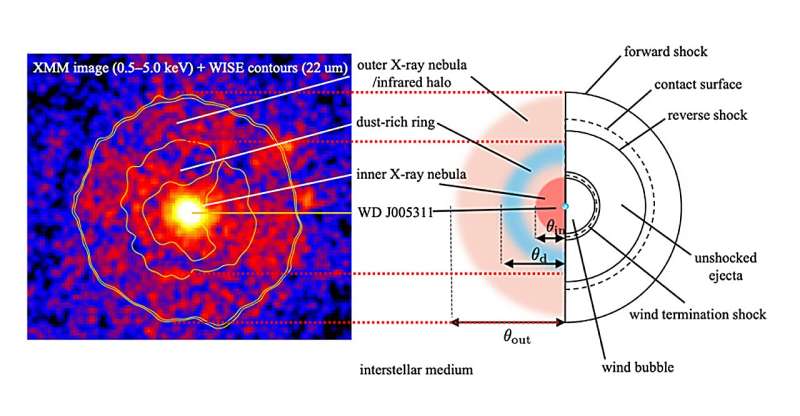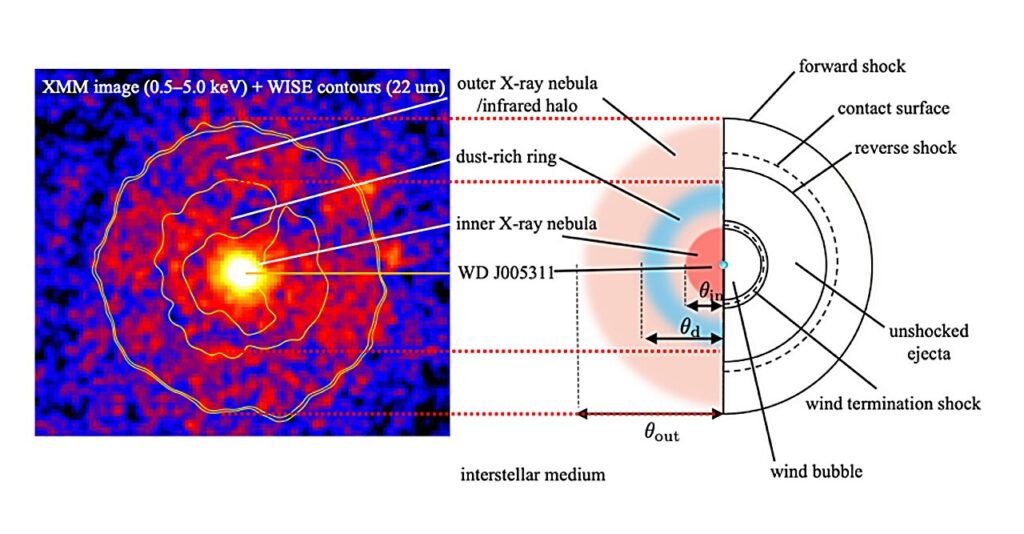
These images show the two impact regions of the remnant SNR 1181. The bright white in the center is a white dwarf star. Credit: 2024 T. Ko, H. Suzuki, K. Kashiyama et al. / The Astrophysical Journal
For the first time, the mysterious remains of a rare type of supernova recorded in 1181 have been uncovered. Two white dwarf stars collided to create a temporary “guest star,” now called Supernova (SN) 1181, which has been recorded in historical documents in Japan and other parts of Asia. However, after the star dimmed, its location and structure remained a mystery, until a research team pinpointed its location in 2021.
Now, through computer modeling and observational analysis, the researchers have reconstructed the structure of the white dwarf remnant, a rare phenomenon that could explain the formation of the double shock wave. They also found that a high-velocity stellar wind may have begun blowing from its surface within just the past few decades. The study is published in the Astrophysical Journal.
The discovery improves our understanding of the diversity of supernova explosions and highlights the benefits of interdisciplinary research, combining history and modern astronomy to enable new discoveries about our galaxy.
The year is 1181 and Japan has just begun the Genpei War (1180-85), which will see a shift in political power from the nobility to a new military-based shogunate established in the coastal city of Kamakura, near present-day Tokyo.
This tumultuous time was recorded in diary form in the Azuma Kagami, which records not only people’s lives and important events (with varying degrees of accuracy) but also everyday occurrences such as the appearance of new stars.
“Historical records from Japan, China and Korea contain numerous references to this transient guest star. At its peak, the star’s brightness rivaled that of Saturn. It was visible to the naked eye for about 180 days, before gradually fading and becoming invisible. The remnants of the SN1181 explosion are now very old, making them dim and difficult to find,” explained lead author Takatoshi Taka, a doctoral student in the University of Tokyo’s Department of Astronomy.
The remains of this guest star, called Supernova Remnant (SNR) 1181, were found to have been created when two extremely dense Earth-sized stars called white dwarfs collided. This produced a rare type of supernova called Type Iax supernova, leaving behind a single bright and rapidly rotating white dwarf star. Aided by observations of its location recorded in historical documents, modern astrophysicists finally pinpointed its location in a nebula in the direction of the constellation Cassiopeia in 2021.

The diagram shows the evolution of the SNR 1181 remnant from the merger of a carbon-oxygen white dwarf and a neon-oxygen white dwarf to the formation of the two shock regions. Credit: 2024 T. Ko
SNR 1181 has been the subject of numerous observational studies due to its unusual nature and location in the Galaxy, which have suggested that it consists of two impact regions, an outer and an inner one. In this new study, the researchers analyzed the latest X-ray data to build a theoretical computer model that explains these observations and reconstruct the previously inexplicable structure of this supernova remnant.
The main challenge is that, according to conventional understanding, when two white dwarfs collide like this, they should explode and disappear. Instead, the merger left behind a white dwarf. A rotating white dwarf would be expected to produce a stellar wind – a fast-moving stream of particles – soon after its formation. But what the researchers found was something else.
“If the winds had started blowing immediately after SNR 1181’s formation, we would not have been able to reproduce the size of the internal shock region that we observed,” Ko said.
“However, by treating the onset time of the wind as a variable, we were able to accurately explain all of SNR 1181’s observed features and unravel the mysterious nature of this high-speed wind. Using numerical calculations, we were also able to simultaneously track the evolution of each impact region over time.”
The team was very surprised to find that their calculations suggest that the wind may have only started very recently – within the last 20 to 30 years – which could indicate that the white dwarf started burning again, as some of the material ejected in the explosion witnessed in 1181 fell onto the white dwarf’s surface, raising its density and temperature above a threshold, resuming combustion.
The team is now preparing further observations of SNR 1181 using the Very Large Array (VLA) in central New Mexico and the 8.2-metre Subaru Telescope in Hawaii to verify their computer model.
“The ability to determine the age and brightness of supernova remnants from an archaeological perspective is a rare and valuable asset for modern astronomy,” Ko said. “Interdisciplinary research like this is exciting and highlights the great potential for combining different fields to discover new aspects of astronomical phenomena.”
Further information: Takatoshi Ko et al, Dynamical model of IRAS 00500+6713: a remnant of type Iax supernova SN 1181 hosting the doubly degenerate merger product WD J005311, The Astrophysical Journal (2024). DOI: 10.3847/1538-4357/ad4d99
Provided by the University of Tokyo
Citation: Elusive temporary star described in historical documents recreated using new computer model (July 5, 2024) Retrieved July 5, 2024 from https://phys.org/news/2024-07-elusive-temporary-star-historical-documents.html
This document is subject to copyright. It may not be reproduced without written permission, except for fair dealing for the purposes of personal study or research. The content is provided for informational purposes only.


